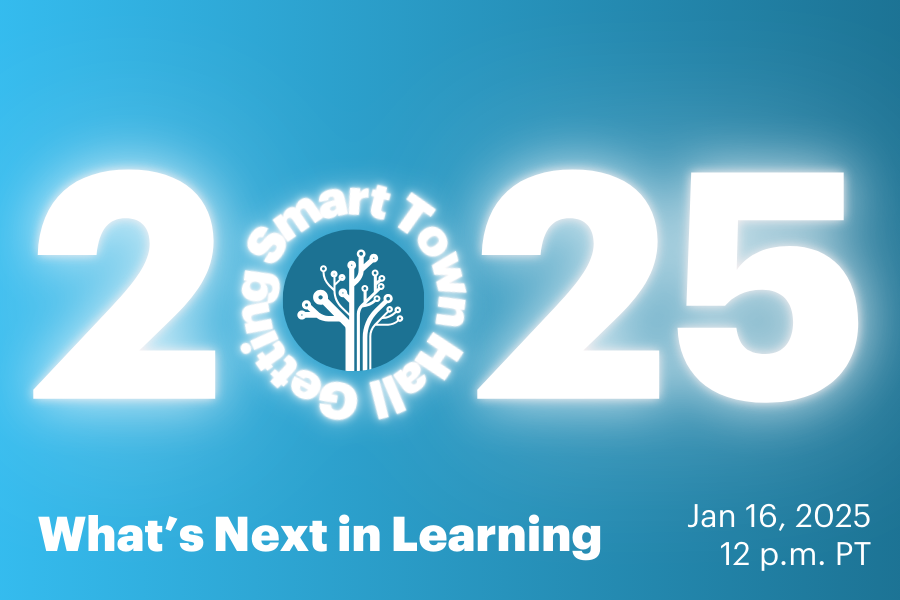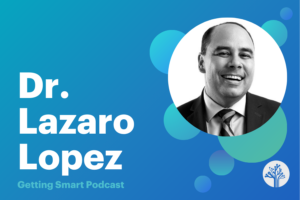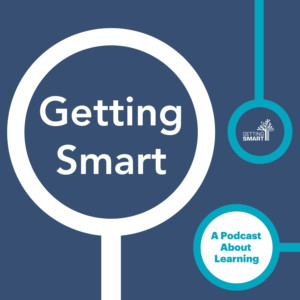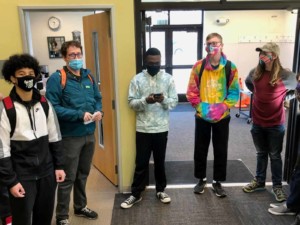Town Hall Recap: What’s Next in Learning 2025

During our “What’s Next in Learning 2025” Town Hall, we dove into some of the most pressing trends shaping the future of education. We kicked things off with a deep dive into the growing impact of artificial intelligence (AI) in classrooms. It’s clear that AI is transforming how students learn and how educators teach. But with this transformation comes new challenges—questions about plagiarism, ethical use, and creating effective policies. We also touched on some exciting advancements in AI tools, like text-to-video and AI companions, and discussed how we can leverage these technologies for personalized and impactful learning experiences while keeping our focus on equitable access and thoughtful governance.
We then explored governance and enrollment trends, which are critical to understanding the evolving educational landscape. We’re seeing a shift away from federal oversight to more localized approaches, with states and communities taking charge of creating meaningful educational goals, like Portraits of Graduates. Declining enrollment in public schools is a reality we can’t ignore—whether it’s due to demographic changes or the rise of micro-schools and alternative learning models. But we also see this as an opportunity to rethink how we prepare students for the future through pathways that include early college programs, industry-recognized credentials, and personalized learning experiences tailored to their unique needs and interests.
Finally, we talked about the essential role of literacy—reading, media, and civic literacy—in preparing young people for a complex, information-rich world. It’s not just about learning to read; it’s about navigating digital content critically and becoming engaged, informed citizens. We’re inspired by the innovative resources and programs out there, from media literacy tools to civics initiatives that help students develop agency and community awareness. As we wrapped up, we reflected on how these trends connect to our broader vision at Getting Smart—ensuring that every learner has access to experiences that are challenging, purposeful, and joyful. This year, we’re committed to pushing the boundaries of what’s possible in education, and we invite everyone to join us in this journey.
Transcript
Mason Pashia: Thank you everyone for joining us for our annual What’s Next in Learning Town Hall. I’m Mason Pashia with Getting Smart. So, these are the trends that the Getting Smart team has identified as things that we’re going to keep talking about, keep thinking about.
And we’re going to dig into some of them a little deeper today, both making the case for why now, like, why are these trends that we’ve spotted as well as what are some things that we’re seeing that are really starting to perk our ears up at what’s possible in each of these spaces. Before we jump in, what do you think are the emerging trends:
I believe that the most important trend or issue in 2025 will be:
- I don’t get really excited about it, but AI
- Mental health and neurodiversity in classrooms
- suppression of content/threats against Federal DOE
- technology
- Shifting accountabilities between fed and states
- Increasing interest/movement towards school choice
- Focusing on the human in the age of AI
- AI
- Asking – how do we know if AI tools are effective?
- Higher Ed Outcomes (employment)
- social learning
- Equity
- humans’ connection to the earth
- Mental Health/Well-Being
- Using AI
- AI
- Student data and privacy/cyber security
- Conservative backlash to progressive education
- “AI and its global and ethical impact
- superintendent exodus
- Staffing
- experiencing disruptions
- Ai
- AI redefining the goal of learning
- AI
- access to major human care and advancement needs
- Personalized Learning
- agent
- escalating personalized learning with AI.
- Protecting civil liberties and student rights
- Microschools
- AI
- Transformation of public education
- Artificial Intelligence integration
- Legitimacy of public education
- misinformation
- School attendance
- engaging in civil discourse
- Explicitly embracing nonacademic learning
- Suggestions that the Dept of Ed will be disbanded.
- figuring out how to leverage GenAI for learning
- workforce alignment
- Big tech influence in politics
- Staff Engagement
- AI
- funding issues related to US DOE CHANGES
- Working with Industries and Higher Education
- Learner-centered design (I hope)
- school choice
- Relationships
- quantum computing
- AI-tools to offer Ss feedback on SEL skills
- In Education – workforce focused learning
- The tension between testing, standards and fun
- School choice
- AI
- Integration of AI into public education
- How to use AI
- AI
- Difficult, hyperlocal political divisions
- AI integration and increased community partnership
- Provide tangible language to learning experience
- Democratic erosion
- Moving learners from dependent to independent.
- Emotional Self Managment: Stress & Anxiety
- Education R&D
- measuring meaningful outcomes
- Politics
- AI and how to use this tool ethically.
- Structural/funding changes at the DOE
- personalized learning enhanced with AI
- AI safety
- AI
- Human Skills
- work related to Skills for the Future Framework
- Embracing AI as a tool for educators and learners
- Developing AI policies and guidelines
- Ignoring the flashiness of AI/tech acceleration
That’s a great list with a lot of overlap with the trends that we are proposing. On ours, we’ve got artificial intelligence, governance, signals of learning. We’ve got literacy, new models for learning, authentic experiences, enrollment and teacher prep being something that’s super important as well. And then just throwing this in right before we jump in. We recently published a blog series on our Getting Smart design principles.
So we say that our goal as an organization is to try and ensure that every child has learning experiences that are accessible, challenging, purposeful, authentic, personalized, and joyful. So we’ve got a blog series that outlines those in more depth, but this is maybe a useful overlay to view everything we’re talking about today, like we’re really trying to intercept these trends and ensure that what comes afterwards has all of these elements.
All right, so we are going to kick off here with Nate on AI. So Nate, take us away.
Artificial Intelligence
Nate McClennen: All right. Hello, everybody. Happy 2025. This is my favorite town hall of the year because I love talking about the things that we’re thinking about, but more importantly, I’d love to get your reaction and see what are we missing.
What should we be thinking about this year at Getting Smart and what should the world be thinking about?
So the why is pretty obvious, probably to all of us, but I just want to put through a few different stats out here is that. The first why is that more students and teachers are using AI, and we know generally in the world more and more people are using AI. Tons and tons of data out there on this. I thought a couple of interesting indicators, the Center for Democracy and Technology talked a lot about, this is from 22, and you can only predict what will happen in 24, 25.
But the student discipline as a result of generative AI use has increased 16 percentage points from two years ago to last school year, and I suspect will continue to increase. What does that mean? More students are using it and thus teachers and schools and leaders are saying, What on earth do we do?
What does plagiarism look like? Is it okay for students to use this? Etc, etc. How do you teach? A landscape that has chat, GPT and other AI tools in it. Walton Family Foundation, a number of you probably saw this, but more and more teachers are using it, a massive increase in educators using it chat, GPT and or other tools.
And then the last thing, this is from post-secondary and higher ed but in higher ed, 86% of students that are using AI in their studies in some way. So bottom line is this thing is here. We all know that. And the big question is how on earth do we address it? And so I want to talk in my second slide, just about what we’re seeing as the education world moving forward.
And then also the industry. So I’m going to start with education on the bottom. Is that we are definitely going to see in 2025 increased efficiency use with things like brisk teaching magic school. I think more and more districts are adopting these tools and using them effectively to help increase efficiencies in teaching and learning.
Second is around policy. I think more and more districts are adopting policies. Teach AI obviously has a bunch of resources on policy if you’re looking for policy templates. And then personalization and all the different things that. The teachers schools, ed tech, et cetera, looking forward to create this holy grail of can every learner have some sort of AI based tutor.
And so that’s moving forward very fast into 2025. So that being said, I feel like those things. Are actually way behind what’s happening in the front end of A. I. And industry. And so I just wanted to point out four different things in industry that are happening. So some of you might have played around with Gemini advance their deep research.
So this is a research tool that if you pay their monthly fee, you get access to, and it does a lot of research on at least Publicly available documents. So not anything that’s password protected. It won’t get access to it, which causes all sorts of things with bias and access. But research tools. So things that are in education that are research oriented for students.
Deep research will do them in really effective and quick ways. Number two is if you haven’t seen any of the new VO two generation from video, this is text to video. So A student can enter a set of text prompts and customized video generated by AI will come out that is unique and original to that particular set of text.
So the imagine, what we are imagining in 2025 is massive propagation of personalized video and created video that’s created at very low cost and text based. So thinking about the creative potential there, but also the mass inundation of media in students worlds who are already inundated with media.
Third trend that we’re seeing that’s way out in front of where we think schools are thinking is this idea of companionship and some of you might have seen the company Friend, which supposedly is launching in 2025. They’re trying to raise some money, but this is a pendant that sits around a person’s neck and is essentially acting as an AI companion all time, 24 hours where it can interact with the individual.
And. In this case, students, if you can imagine what would happen if in their AirPods or in their necklace, they always had access to information, AI information. And then finally, the big one we’ve written a little bit about this, is that just this idea of agentic behavior, AI tools that are doing things for students and doing things for teachers autonomously and not with step-by-step directions like you do in current bots.
So the rise of agents is the most important thing that we’re gonna see in 2025. This trend, there’s a lot going on in education around efficiency, policy, and personalization, and there’s way more that’s farther, farther out that we need to be thinking about. How is this dramatically going to shift the education landscape?
Tom Vander Ark: Nate, on the subject of agentic AI in that category of personalization, I think guidance and support is an emerging category. I think we have George Tang on from Visela. George, is your new startup in the guidance space? You want to say anything about that trend?
George Tang: It is Tom, and we’re excited to see where and how we can build agents to be able to both elicit authentic student voice, but then agents to then codify open responses from students to then develop thoughtful profiles and recommendations that end up empowering students to take more ownership over their learning journey.
Tom Vander Ark: Thank you. Ian at Schooljoy would agree that voice is a big development. Our friends at Amira , AI powered reading platform but it emphasis there is on encouraging kids to read out loud and AI is just in the last year has become so much better at, uh, at hearing so multimodal and guidance AI.
Governance
Thanks, George. There’s also some interesting higher ed startups in the guidance space. Our second big trend. Is or non trend, maybe is governance. Maybe the big trend is what is not happening in the governance space.
Nate talked about a I and I would say, other than some late gestures by the federal government most education and state governments have been slow to respond to a I so I think we’re still in a full scramble to understand. Adequate public policy to protect particularly youth from AI challenges.
The big trend here that we’re going to see more of this year is just is just that the devolution from from federal to state we’re seeing the end of the unraveling of what started as NCLB states are stopping testing or making it more optional with, without really adding much of a governance frame behind it there, there’s.
We’ll argue in a new paper that will come out in the next few days. There’s an emerging local response, regional response, which is creating new learning goals, usually in a portrait of graduate or a profile of a learner, creating an assessment system around those broader goals, and then developing new and better signals of progress.
Nate will talk about. All of those. We’re excited about that, but that’s it’s really a bottoms up approach rather than top down. Gretchen, what else would you add on what we’re seeing in governance or maybe what we’re not seeing in governance?
Gretchen Morgan: I think I’ll just add actually something we didn’t talk too much about earlier today, Tom, but it’s that I think in the absence of that really clear federal direction and accountability, we have two or three generations of education leaders who don’t know how to lead without that.
Tom Vander Ark: Almost everybody in the system has grown up in, in the standards assessments and accountability frame, and our entire mindset is around promoting grade level proficiency. And assuming that there’s a big hammer if we don’t
Gretchen Morgan: which means every idea I bring as a leader is legitimate because they told me because it meets this requirement because whatever, and I just know that my job is to execute that and show up and feel badly about it when you don’t like it.
But I just think we have a huge leadership gap who don’t know how to lead behind them.
Tom Vander Ark: And I guess the other big trend I’ll mention is I think we’re going to see continuing slow growth of. Of education funding outside the system in the form of vouchers and education savings accounts. And so Gretchen, there are hundreds of thousands of people thinking outside the system about innovation, but completely outside the context of of accountability.
And as you and I discussed in the last hour, we’re going to start to see that evidence of the problems with. With so many kids learning outside any form of accountability, but I don’t that’s not going to be a big story this year. It’s probably a 2027 story. But Gretchen, thanks to you and your colleagues for thinking hard about governance.
It’s a subject that won’t get the attention it deserves in 2025, absent a few people like you doing important work.
Nate, I mentioned that signals are an important trend. What do we mean by that?
Signals
Nate McClennen: Yeah. So signals, couple of big things here. So why do we think these are important in 2025? We’ve been talking about skills for the last couple of years and more in a variety of ways and whether those are core skills or that are typically taught in K 12 or their technical skills that are specific to an industry, maybe found in CTE programs, or our favorite right now, durable and transferable skills.
All those things are important. And yet so what we see in the industry world so where our young people end up is that more and more employers are using skills based hiring. So instead of relying on a proxy of say a degree or a college or a high school diploma or something like that, they’re, they are more interested in saying what are the particular skills.
That this potential hire can have so that they can be best placed in our organization or company. There’s a lot of complexities to this, but more and more companies are saying it’s important. It’s useful. And those that we hire this way last longer and are better employees for us. So that’s number one.
Why? I think the second why is that we are seeing the number of portraits of graduates or profiles of learners or learner profiles, whatever you like to call them. It is growing fast and more and more states at the national level. District schools are saying here’s the North Star for the students in our organization and in our school.
And so you have examples like the future nine competencies, execute competencies, durable skills. These are all national level. Platforms and competencies that have been built out all of them really elegant and interesting. The, I put Cass’s Northern Cass’s Portrait of a Learner as an example of a school one in the upper right so many schools are either adapting their state level version, which I put down here in the lower right is Kentucky Department of Education.
So we’re knowing that we know that a lot of these portraits are growing in the country and the big worry that we have in 2025 and onward is, Do they just remain a poster on the wall? So we think that there’s gonna be more and more need and more and more effort to say how can we credential skills and how can these skills be related to our portraits of graduates?
We put out a portrait model on our website. Around portrait of a graduate supported by the system supported by a portrait of an educator and leader. Each one of these concentric rings are important to make sure that each child reaches their full potential. What does that look like for 2025 specifically?
We think that there’s going to be broader use of extended transcripts. These are transcripts beyond what in the typical number one here. The ones that most of us got if you graduated from high school and or college, you got a transcript to set courses, grades, GPA. So we’re going to see more and more examples of extended transcripts.
And so clearly the revised CTE model will allow for more industry recognized credentials. And that’s been happening for a long time. Sometimes they’re on transcripts, sometimes they’re not. So we’ll see more and more. IRCs located on transcripts. I think we’re going to see more and more what stage number three, this extended transcripts light version of how do we authenticate, validate, and verify real world learning experiences and other opportunities that, that young people have earned.
And so I put on the top here, this is Ohio. To graduate now from an Ohio high school, you need to have at least two seals associated with these 12 seals right here in addition to your course requirements and other items for graduation. So we’re going to see more and more opportunities in more and more states for students to have something else, and sometimes that will just emerge as a tassel when they graduate or a cord when they graduate.
And some of it will be stamped on their transcripts, and some of them will be industry recognized credentials, but we’re gonna broaden that transcript more and more in 20, 2025, and then we’ll see more and more states jumping on to the L. A. R. E. C. O. System. States like Alabama has led the way along with a few other states of saying This is important for our state.
We’re going to connect post secondary education with the workforce with K 12 and we’re going to use some sort of digital learning and employment record ecosystem. So based on skills based hiring, the reaction to that around creating profiles of graduates to document those and then a way to show those as real signaling on a young person’s transcript or learning and employment record is what’s going to happen in 2025.
All right, literacy. I think this is handing off to Victoria.
Literacy
Victoria Andrews: Normally when people hear the words literacy, they typically just think of reading, but literacy is so complex now, given all of the different changes that I’ve we’ve experienced in the last couple of years. So we’re going to dive in.
We are going to start off with reading literacy. Why? Because low quality resources impact literacy skills. And when we’re talking about literacy for reading, we’re talking about the essential knowledge and skills to be able to navigate your daily life. Unfortunately, right now, 34 percent of kindergartners lack the basic skills that they need.
And some might even argue, hey, if I’m a kindergartner, I don’t really have. Quote unquote skills going into kindergarten, but that’s not true. So those that have access to early education childhood education, we find that they are in a better position to, to meet the needs and the demands to become a really great reader.
67 percent of fourth graders are at or below greeting level. We’re not here to argue about greeting reading level, but just their level of readiness and their preparedness to move on to more challenging content. When we, when there’s a struggle for literacy, we know that inhibits children’s access to knowledge, to interact in, interaction and socialization, even Self esteem because they’re less inclined to want to engage in activities that require any level of reading and we know that reading is not just in isolation, but it’s going to touch on other content levels as well as those durable skills too.
So we’re looking at how can we address that. And we’re also somebody, a lot of people dropped in the chat, media literacy. Woo. I believe it’s generation alpha. They are like basically born with tick tock in their brain. And so they are just inundated with the number of the sheer number of hours that our young people are exposed to media and how to navigate that terrain.
Some, you wouldn’t give a six year old the keys to your car, but we give our six year olds keys, an iPad or iPhone, and we don’t really discuss with them how is this okay? What are the parameters? So we’re really seeing in 2025 how to make sure our young people are thoroughly equipped with the, just the The tsunami of information that we place them in every day.
This is just a nationwide view of the different legislation that is in support for helping our children have access to how to handle that. I know that somebody dropped in the chat that there was I think it was in New York. Andy or Randy Squire mentioned that there was some policies out in New York.
I would love to see that. And if you can link those, that’d be even great. So media literacy, the need to make sure that we are supporting our young people. And that looks like how to tell whether or not information is true or accurate, how to critically assess that information and to even think, Oh is this site legit?
Is this picture legit? If it’s AI generated, why are there six fingers? All of those key things that we’re discovering. So our students and our young people need access to that too. We’re talking about literacy. We’re also talking about civic literacy. I didn’t see this one in the chat, but I there’s it’s now to 66.
So hopefully somebody drops in the chat civic literacy. There is a demand from our young people who are very socially activated for they want it. They want to know what it means to be a member of a community citizen. To be responsible in that way and how they can do that. And so if we look at the current requirements across the nation in regards to civics, it’s not where we quite need to be and even in that those there’s such a level of variance.
So some states require for students to take questions off of the citizenship test, which, if you haven’t taken that, I encourage you to give it a little try, or even it’s a very, you’d be surprised, you’d be surprised. Get back to us when you take that test. But. Our young people are demanding that.
So how can they be engaged? That’s something that we’re seeing in 2025 as well. It was mentioned before with Nate and AI, but AI education and guidance—this is from our friends at AI for Education.
I think there was somebody who had a podcast with Amanda earlier, and they just put out a wealth of resources. In 2025, we’re seeing the need for AI guidance. It doesn’t have to be perfect, but we need to have some parameters for our young people. Less than half the states have any guidelines whatsoever.
Because of the increasing reliance on AI and agents and incorporating that into learning, it’s essential—not just for our young people, but for our educators and policymakers as well. It’s not limited to them; families also need awareness and support.
We’re seeing some really promising trends. For example, with media literacy, there are great organizations putting out free resources for families and learning institutions to help navigate what AI usage might look like. These resources are accessible and often easy for educators to integrate into their existing projects and lessons.
When it comes to civics literacy, we love the work that iCivics is doing, sharing community projects young people can get involved in. The Social Studies Accelerator, powered by Adlock, offers educators access to culturally relevant historical information, helping provide a holistic view of history where all students can see themselves represented. Civics Unplugged is another amazing program that funds civics projects.
As for AI literacy, there’s a fantastic framework from our friends at Digital Promise. It includes tools for creation and understanding algorithms, ensuring students are not just consumers but informed members of society.
High-quality literacy resources, like those from the National Center for Families Learning, are also making an impact. They provide free materials, taking a holistic approach to literacy by involving entire families. Literacy doesn’t just impact individuals; it influences entire households.
Tom Vander Ark: Thanks, Victoria. As Andy Calkins referenced, the Middle States Association, a school accrediting body, just released the first segments of an AI endorsement framework. It’s a beautiful resource for teaching AI. Amanda Bickerstaff and I were on the advisory group for that, and we really like the idea of an endorsement or credentialing system for schools to encourage AI literacy for students, staff, and communities.
Enrollment
All right, another negative trend: enrollment. It’s down—and it’s bad. In most public districts, enrollment is down a few percentage points. We didn’t see a significant snap-back in enrollment post-pandemic, and many kids have left the system for homeschooling. In the 17 states with education savings accounts, many students are moving to private schools.
While most private schools are existing ones, many new private micro-schools are forming. This seems to be a permanent trend. The graph on the left shows the enrollment projections have declined significantly over the past five years. Changing demographics, including lower birth rates and fewer teenagers, are part of the issue. However, some regions are still growing—particularly sunny areas—but northern latitude states are experiencing considerable losses.
What’s troubling is that administrative staff levels have continued to grow despite shrinking student numbers. Many districts used federal ESSER funds to hire additional staff, creating real financial challenges. Across the U.S., we’re seeing dozens of urban systems bankrupt and thousands of districts in dire straits.
New Models
Victoria Andrews: Right on the heels of enrollment challenges, let’s talk about how this impacts us. Some states are expanding ESAs, like Texas and Tennessee, in 2025. Families are hungry for private and personalized learning options, leading to the rise of microschools. Leaders like Tiffany Blassingame of Ferguson School in Atlanta are meeting this demand with innovative early elementary models.
Parents want their children to develop agency, durable skills, and opportunities to engage as active citizens. Schools are creating accelerated pathways, including industry-recognized credentials and early college programs like P-TECH, ensuring students graduate with diplomas and additional qualifications like associate degrees or internships.
Experience-Based Learning
Tom Vander Ark: Thanks, Victoria. In a related trend, authentic, community-connected experiences are gaining traction. Programs like CAPS Network and initiatives in Kansas City are integrating powerful real-world projects into their models. These are experiences students remember for decades—they shape agency, identity, and purpose.
Purdue Polytechnic and the P-TECH program continue expanding, offering applied learning pathways that combine early college education with work-based learning. Ripon’s client project platform is also being used by over 640 colleges to foster meaningful experiences for students.
Victoria Andrews: Finally, let’s touch on teacher preparation. Retaining strong principals and teachers has been a challenge, but programs like “Raise the Bar” and Grow Your Own models are helping diversify and strengthen the teacher workforce. Apprenticeship programs are expanding, making entry into teaching more accessible. Nevada State University’s College of Education, for instance, embeds wellness into teacher prep, ensuring teachers are supported holistically.
Mason Pashia: Thank you all for participating in this whirlwind town hall. Over the next year, we’ll dive deeper into these themes. Stay tuned for updates—and keep sharing innovations loudly!
Links
- Watch the full video here
- What’s Next in Learning 2024 Recap
- Getting Smart’s AI in Education Publication
- Getting Smart’s Portrait Model Publication
- Getting Smart Town Hall on Microschools
- Expanding Access, Value and Experiences Through Credentialing
- AI Literacy
- AI Postsecondary
- Helping Employers Move Beyond Degrees from Michael B Horn
- Manifesto for Confronting Education from the BQI Community
- Responsible AI in Learning from Middle States Association
- Why It’s Hard to Control What Gets Taught in Public Schools Article
- NCSS Annual Conference
- The Education of a Statesman
- Escape the Echoes
- Podcast: The Privateers: How Billionaires Created a Culture War and Sold School Vouchers w/ Josh Cowen
- EdSource: Chronic absenteeism: A symptom of an outdated school system?
- Article on Shrinking Indianapolis Schools
- Honoring Each Learner: How to Develop Individualized Learning Plans for All Students
- Ohio’s Graduation Seals
- Teaching in Teams YouTube Playlist
- Video on Michigan Schools
- Thinking Beyond Teacher Shortages
- Collective Shift

Mason Pashia

Tom Vander Ark

Nate McClennen







0 Comments
Leave a Comment
Your email address will not be published. All fields are required.